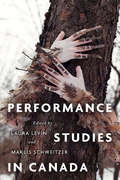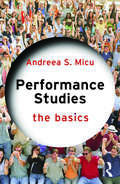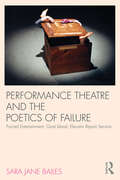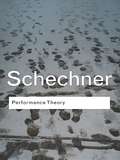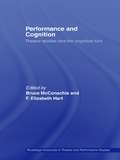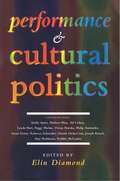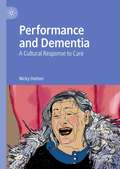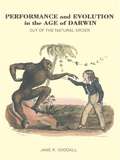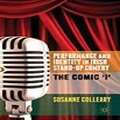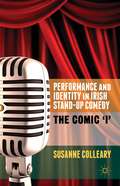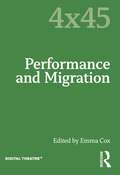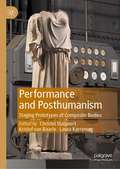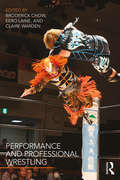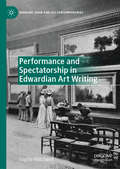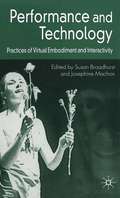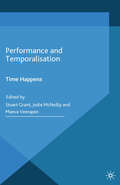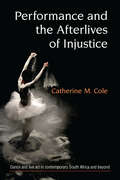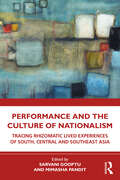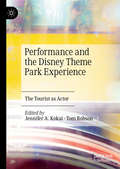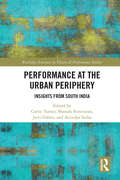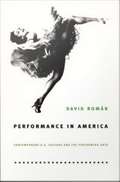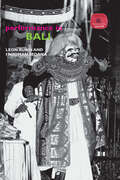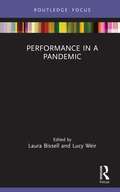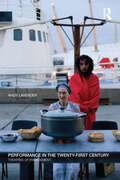- Table View
- List View
Performance Studies in Canada
by Laura Levin Marlis SchweitzerSince its inception as an institutionalized discipline in the United States during the 1980s, performance studies has focused on the interdisciplinary analysis of a broad spectrum of cultural behaviours including theatre, dance, folklore, popular entertainments, performance art, protests, cultural rituals, and the performance of self in everyday life. Performance Studies in Canada brings together a diverse group of scholars to explore the national emergence of performance studies as a field in Canada. To date, no systematic attempts has been made to consider how this methodology is being taught, applied, and rethought in Canadian contexts, and Canadian performance studies scholarship remains largely unacknowledged within international discussions about the discipline. This collection fills this gap by identifying multiple origins of performance studies scholarship in the country and highlighting significant works of performance theory and history that are rooted in Canadian culture. Essays illustrate how specific institutional conditions and cultural investments – Indigenous, francophone, multicultural, and more – produce alternative articulations of “performance” and reveal national identity as a performative construct. A state-of-the-art work on the state of the field, Performance Studies in Canada foregrounds national and global performance knowledge to invigorate the discipline around the world.
Performance Studies: The Basics (The Basics)
by Andreea S. MicuPerformance Studies: The Basics offers an overview of the multiple, often overlapping definitions of performance, from performance art, performance as everyday life, and rituals, to the performative dimensions of identity, such as gender, race and sexuality. This book defines the interdisciplinary field of performance studies as it has evolved over the past four decades at the intersection of academic scholarship and artistic and activist practices. It discusses performance as an important means of communicating and of understanding the world, highlighting its intersections with critical theory and arguing for the importance of performance in the study of human behaviour and social practices. Complete with a helpful glossary and bibliography, as well as suggestions for further reading, this book is an ideal starting point for those studying performance studies as well as for general readers with an interest in the subject.
Performance Theatre and the Poetics of Failure
by Sara Jane BailesWhat does it mean to "fail" in performance? How might staging failure reveal theatre’s potential to expand our understanding of social, political and everyday reality? What can we learn from performances that expose and then celebrate their ability to fail? In Performance Theatre and the Poetics of Failure, Sara Jane Bailes begins with Samuel Beckett and considers failure in performance as a hopeful strategy. She examines the work of internationally acclaimed UK and US experimental theatre companies Forced Entertainment, Goat Island and Elevator Repair Service, addressing accepted narratives about artistic and cultural value in contemporary theatre-making. Her discussion draws on examples where misfire, the accidental and the intentionally amateur challenge our perception of skill and virtuosity in such diverse modes of performance as slapstick and punk. Detailed rehearsal and performance analysis are used to engage theory and contextualise practice, extending the dialogue between theatre arts, live art and postmodern dance. The result is a critical account of performance theatre that offers essential reading for practitioners, scholars and students of Performance, Theatre and Dance Studies.
Performance Theory
by Richard SchechnerFew have had quite as much impact in both the academy and in the world of theatre production as Richard Schechner. For more than four decades his work has challenged conventional definitions of theatre, ritual and performance. When this seminal collection first appeared, Schechner's approach was not only novel, it was revolutionary: drama is not just something that occurs on stage, but something that happens in everyday life, full of meaning, and on many different levels. Within these pages he examines the connections between Western and non-Western cultures, theatre and dance, anthropology, ritual, performance in everyday life, rites of passage, play, psychotherapy and shamanism.
Performance and Cognition: Theatre Studies and the Cognitive Turn (Routledge Advances in Theatre & Performance Studies)
by Bruce McConachie F. Elizabeth HartThis anthology is the first of its kind. In addition to opening up fresh perspectives on theatre studies – with applications for dramatic criticism, performance analysis, acting practice, audience response, theatre history, and other important areas – the book sets the agenda for future work, helping to map the emergence of this new approach. Following a comprehensive introduction, the contributors examine: the interfaces between cognitive studies and Lacanian psychoanalysis, phenomenology and communication theory different ideas from cognitive studies that open up the meanings of several plays the process of acting and the work of Antonio Damasio theatrical response: the dynamics of perception, and the riots that greeted the 1907 production of The Playboy of the Western World. This original and authoritative work will be attractive to scholars and graduate students of drama, theatre, and performance.
Performance and Cultural Politics
by Elin DiamondPerformance and Cultural Politics is a groundbreaking collection of essays which explore the historical and cultural territories of performance, written by the foremost scholars in the field. The essays, exploring performance art, theatre, music and dance, range from Oscar Wilde to Eric Clapton; from the Rose Theatre to U.S. Holocaust museums. The topic includes: * Sex Play: Stereotype, Pose and Dildo * Grave Performances: The Cultural Politics of Memory * Genealogies: Critical Performances * Identity Politics: Passing, Carnival and the Law In the concluding section, `Performer's Performance', performance artist Robbie McCauley offers the practitioner's perspective on performance studies. Interdisciplinary, thought-provoking and rich in new ideas, Performance and Cultural Politics is a landmark in the emerging field of performance studies.
Performance and Dementia: A Cultural Response to Care
by Nicky HattonThis book explores how theatre and performance can change the way we think about dementia and some of the environments in which dementia care takes place. Drawing on the author’s creative practice and other performance projects in the UK, it explores some of the challenges and opportunities of making performance in care homes. Rather than focusing on the transformative potential of the arts, it asks how artists can engage with the different types of relationships that exist in a care community. These include the relationships that residents and staff have with each other as well as relationships with care spaces. Exploring the intersection between participatory performance and the everyday creativity of a care home, it argues that the arts have a cultural role to play in supporting dementia care as a relational practice. Moreover, it celebrates the intrinsic creativity of caregiving and how principles and practices of care work can inform theatre and performance in diverse ways.
Performance and Evolution in the Age of Darwin: Out of the Natural Order
by Jane GoodallPerformance and Evolution in the Age of Darwin reveals the ways in which the major themes of evolution were taken up in the performing arts during Darwin's adult lifetime and in the generation after his death. The period 1830-1900 was the formative period for evolutionary ideas. While scientists and theorists investigated the law and order of nature, show business was more concerned with what was out of the natural order. Missing links and throwbacks, freak taxonomies and exotic races were favourite subject matter for the burgeoning variety theatre movement. Focusing on popular theatre forms in London, New York and Paris, Jane Goodall shows how they were interwoven with the developing debate about human evolution. With this book, Goodall contributes an important new angle to the debates surrounding the history of evolution. She reveals that, far from creating widespread culture shock, Darwinian theory tapped into some of the long-standing themes of popular performance and was a source for diverse and sometimes hilarious explorations.
Performance and Identity in Irish Stand-Up Comedy
by Susanne CollearyPerformance and Identity in Irish Stand-Up Comedy examines the comic tradition of stand-up in and from modern-day Ireland. Using critical analyses of comedians including Tommy Tiernan, Dylan Moran and Maeve Higgins, Susanne Colleary's engaging new book explores the role of stand-up in contemporary culture and examines the role of the staged comic self in performance. This book is suitable for students and scholars of international performance, and general readers interested in the interplay between comedy and society in contemporary cultural thought.
Performance and Identity in Irish Stand-Up Comedy: The Comic 'i'
by S. CollearyOne of the cultural phenomena to occur in Ireland in the last two decades has been the highly successful growth of stand-up comedy as a popular entertainment genre. This book examines stand-up comedy from the perspective of the narrated self, through the prism of the fabricated comedy persona, including Tommy Tiernan, Dylan Moran and Maeve Higgins.
Performance and Identity in the Classical World
by Anne DuncanActors in the classical world were often viewed as frauds and impostors, capable of deliberately fabricating their identities. Conversely, they were sometimes viewed as possessed by the characters that they played, or as merely playing themselves onstage. Numerous sources reveal an uneasy fascination with actors and acting, from the writings of elite intellectuals (philosophers, orators, biographers, historians) to the abundant theatrical anecdotes that can be read as a body of "popular performance theory. " This study examines these sources, along with dramatic texts and addresses the issue of impersonation, from the late fifth century BCE to the early Roman Empire.
Performance and Migration (4x45)
by Emma CoxThis third volume in the 4x45 series addresses some of the most current and urgent performance work in contemporary theatre practice. As people from all backgrounds and cultures criss-cross the globe with an ever-growing series of pushes and pulls guiding their movements, this book explores contemporary artists who have responded to various forms of migration in their theatre, performance and multimedia work. The volume comprises two lectures and two curated conversations with theatre-makers and artists. Danish scholar of contemporary visual culture, Anne Ring Petersen, brings artistic and political aspects of ‘postmigration’ to the fore in an essay on the innovations of Shermin Langhoff at Berlin’s Ballhaus Naunynstraße, and the decolonial work of Danish-Trinidadian artist Jeannette Ehlers. The racialised and gendered exclusions associated with navigating ‘the industry’ for non-white female and non-white non-binary artists are interrogated in Melbourne-based theatre scholar Paul Rae’s interview with two Australian performers of Indian heritage, Sonya Suares and Raina Peterson. UK playwrights Joe Murphy and Joe Robertson of Good Chance Theatre discuss their work in dialogue, and with their colleague, Iranian animator and illustrator Majid Adin. Emma Cox’s essay on Irish artist Richard Mosse’s video installation, Incoming, discusses thermographic ‘heat signatures’ as a means of seeing migrants and the imperative of envisioning global climate change. An accessible and forward-thinking exploration of one of contemporary performance’s most pressing influences, 4x45 | Performance and Migration is a unique resource for scholars, students and practitioners of Theatre Studies, Performance Studies and Human Geography.
Performance and Posthumanism: Staging Prototypes of Composite Bodies
by Christel Stalpaert Kristof Van Baarle Laura KarremanRecent technological and scientific developments have demonstrated a condition that has already long been upon us. We have entered a posthuman era, an assertion shared by an increasing number of thinkers such as N. Katherine Hayles, Rosi Braidotti, Donna Haraway, Bruno Latour, Richard Grusin, and Bernard Stiegler. The performing arts have reacted to these developments by increasingly opening up their traditionally ‘human’ domain to non-human others. Both philosophy and performing arts thus question what it means to be human from a posthumanist point of view and how the agency of non-humans – be they technology, objects, animals, or other forms of being – ‘works’ on both an ontological and performative level. The contributions in this volume brings together scholars, dramaturgs, and artists, uniting their reflections on the consequences of the posthuman condition for creative practices, spectatorship, and knowledge.
Performance and Professional Wrestling
by Claire Warden Broderick Chow Eero LainePerformance and Professional Wrestling is the first edited volume to consider professional wrestling explicitly from the vantage point of theatre and performance studies. Moving beyond simply noting its performative qualities or reading it via other performance genres, this collection of essays offers a complete critical reassessment of the popular sport.Topics such as the suspension of disbelief, simulation, silence and speech, physical culture, and the performance of pain within the squared circle are explored in relation to professional wrestling, with work by both scholars and practitioners grouped into seven short sections: Audience Circulation Lucha Gender Queerness Bodies Race A significant re-reading of wrestling as a performing art, Performance and Professional Wrestling makes essential reading for scholars and students intrigued by this uniquely theatrical sport.
Performance and Spectatorship in Edwardian Art Writing (Bernard Shaw and His Contemporaries)
by Sophie HatchwellThis book explores how Edwardian art writing shaped and narrated embodied, performative forms of aesthetic spectatorship. It argues that we need to expand the range of texts we think of as art writing, and features a diverse array of critical and fictional works, often including texts that are otherwise absent from art-historical study. Multi-disciplinary in scope, this book proposes a methodology for analyzing the aesthetic encounter within and through art writing, adapting and reworking a form of phenomenological-semiotic analysis found conventionally in performance studies. It focuses on moments where theories of spectatorship meet practice, moving between the varied spaces of Edwardian art viewing, from the critical text, to the lecture hall, the West End theatre and gallery, middle-class home, and fictional novel. It contributes to a rethinking of Edwardian culture by exploring the intriguing heterogeneity and self-consciousness of viewing practices in a period more commonly associated with the emergence of formalism.
Performance and Technology: Practices of Virtual Embodiment and Interactivity (Palgrave Studies In Performance And Technology Ser.)
by Susan Broadhurst Josephine MachonThis collection interrogates the interaction between new technologies and performance practice, linking the sensuous contact that must exist between the physical and virtual, together with the resultant corporeal transformation. It features writings from international contributors who specialize in digital art and performance practices.
Performance and Temporalisation: Time Happens (Performance Philosophy)
by Jodie McNeilly Maeva VeerapenPerformance and Temporalisation features a collection of scholars and artists writing about the coming forth of time as human experience. Whether drawing, designing, watching performance, being baptised, playing cricket, dancing, eating, walking or looking at caves, each explores the making of time through their art, scholarship and everyday lives.
Performance and the Afterlives of Injustice (Theater: Theory/Text/Performance)
by Catherine ColeIn the aftermath of state-perpetrated injustice, a façade of peace can suddenly give way, and in South Africa and the Democratic Republic of Congo, post-apartheid and postcolonial framings of change have exceeded their limits. Performance and the Afterlives of Injustice reveals how the voices and visions of artists can help us see what otherwise evades perception. Embodied performance in South Africa has particular potency because apartheid was so centrally focused on the body: classifying bodies into racial categories, legislating where certain bodies could move and which bathrooms and drinking fountains certain bodies could use, and how different bodies carried meaning. The book considers key works by contemporary performing artists Brett Bailey, Faustin Linyekula, Gregory Maqoma, Mamela Nyamza, Robyn Orlin, Jay Pather, and Sello Pesa, artists imagining new forms and helping audiences see the contemporary moment as it is: an important intervention in countries long predicated on denial. They are also helping to conjure, anticipate, and dream a world that is otherwise. The book will be of particular interest to scholars of African studies, black performance, dance studies, transitional justice, as well as theater and performance studies.
Performance and the Culture of Nationalism: Tracing Rhizomatic Lived Experiences of South, Central and Southeast Asia
by Sarvani Gooptu and Mimasha PanditThis book studies the intersection of performance and nationalism in South Asia.It traces the emergence of the culture of nationalism from the late nineteenth century through to contemporary times. Drawing on various theatrical performance texts, it looks at the ways in which performative narratives have reflected the national narrative and analyses the role performance has played in engendering nationhood. The volume discusses themes such as political martyrdom as performative nationalism, the revitalisation of nationalism through new media, the sanitisation of physical gestures in dance, the performance of nationhood through violence in Tajiki films, as well as K-Pop and the new northeastern identity in India. A unique contribution to the study of nationalism, this book will be useful for scholars and researchers of history, theatre and performance studies, cultural studies, postcolonial studies, modern India, Asian studies, political studies, social anthropology and sociology.
Performance and the Disney Theme Park Experience: The Tourist as Actor
by Jennifer A. Kokai Tom RobsonThis book addresses Disney parks using performance theory. Few to no scholars have done this to date—an enormous oversight given the Disney parks’ similarities to immersive theatre, interpolation of guests, and dramaturgical construction of attractions. Most scholars and critics deny agency to the tourist in their engagement with the Disney theme park experience. The vast body of research and journalism on the Disney “Imagineers”—the designers and storytellers who construct the park experience—leads to the misconception that these exceptional artists puppeteer every aspect of the guest’s experience. Contrary to this assumption, Disney park guests find a range of possible reading strategies when they enter the space. Certainly Disney presents a primary reading, but generations of critical theory have established the variety of reading strategies that interpreters can employ to read against the text. This volume of twelve essays re-centers the park experience around its protagonist: the tourist.
Performance at the Urban Periphery: Insights from South India (Routledge Advances in Theatre & Performance Studies)
by Anindya Sinha Sharada Srinivasan Jerri Daboo Cathy TurnerThis edited volume considers performance in its engagement with expanding Indian cities, with a particular focus on festivals and performances in Karnataka, Tamil Nadu and Kerala. The editors ask how performance practices are affected by urbanisation, the effects of such changes on their cultural economy, and the environmental impacts of performance itself. This project also considers how performance responds to its context, and the potential for performance to be critical of the city’s development, and of its own compromises. Bringing together perspectives from the humanities, natural and social sciences, the book takes a multi-faceted analytical view of live performance, connecting contemporary with heritage forms, and human with more-than-human actors. The three sections, themed around heritage, everyday life, and future ecologies, will be of great interest to students and scholars in performance, heritage studies, ecology and art history.
Performance in America: Contemporary U.S. Culture and the Performing Arts
by David RománPerformance in America demonstrates the vital importance of the performing arts to contemporary U. S. culture. Looking at a series of specific performances mounted between 1994 and 2004, well-known performance studies scholar David Romn challenges the belief that theatre, dance, and live music are marginal art forms in the United States. He describes the crucial role that the performing arts play in local, regional, and national communities, emphasizing the power of live performance, particularly its immediacy and capacity to create a dialogue between artists and audiences. Romn draws attention to the ways that the performing arts provide unique perspectives on many of the most pressing concerns within American studies: questions about history and politics, citizenship and society, and culture and nation. The performances that Romn analyzes range from localized community-based arts events to full-scale Broadway productions and from the controversial works of established artists such as Tony Kushner to those of emerging artists. Romn considers dances produced by the choreographers Bill T. Jones and Neil Greenberg in the mid-1990s as new aids treatments became available and the aids crisis was reconfigured; a production of the Asian American playwright Chay Yew's A Beautiful Country in a high-school auditorium in Los Angeles's Chinatown; and Latino performer John Leguizamo's one-man Broadway show Freak. He examines the revival of theatrical legacies by female impersonators and the resurgence of cabaret in New York City. Romn also looks at how the performing arts have responded to 9/11, the U. S. invasion of Afghanistan, and the second war in Iraq. Including more than eighty illustrations, Performance in America highlights the dynamic relationships among performance, history, and contemporary culture through which the past is revisited and the future reimagined.
Performance in Bali
by Leon Rubin I. Nyoman SedanaLeon Rubin and I Nyoman Sedana, both international theatre professionals as well as scholars, collaborate to give an understanding of performance culture in Bali from inside and out. The book describes four specific forms of contemporary performance that are unique to Bali: Wayang shadow-puppet theatre Sanghyang ritual trance performance Gambuh classical dance-drama the virtuoso art of Topeng masked theatre. These culturally unique and beautiful theatrical events are contextualised within religious, intellectual and social backgrounds to give unparalleled insight into the mind and world of the Balinese performer.
Performance in a Pandemic
by Laura BissellThis edited collection gathers UK and international artists, academics, practitioners, and researchers in the fields of contemporary performance, dance, and live art to offer creative-critical responses to the impact of the COVID-19 pandemic on their work. Themes addressed in these case studies include the ways in which liveness functions across digital platforms, the new demands on audiences and performance-makers, and the impact on international festivals as the digital removes geographical and locational restrictions. Brought together, these examples capture the creative activity and output that this unexpected cultural moment has provoked. Creative-critical responses interrogate what the global pandemic has taught us about what it is to make live work during lockdown and explore what the future of performance-making in a post-COVID world might look like. For all scholars and performance-makers whose work brings them into the sphere of contemporary art and culture, this is an essential and stimulating account of practice at the beginning of the 2020s.
Performance in the Twenty-First Century: Theatres of Engagement
by Andy LavenderPerformance in the Twenty-First Century: Theatres of Engagement addresses the reshaping of theatre and performance after postmodernism. Andy Lavender argues provocatively that after the ‘classic’ postmodern tropes of detachment, irony, and contingency, performance in the twenty-first century engages more overtly with meaning, politics and society. It involves a newly pronounced form of personal experience, often implicating the body and/or one’s sense of self. This volume examines a range of performance events, including work by both emergent and internationally significant companies and artists such as Rimini Protokoll, Blast Theory, dreamthinkspeak, Zecora Ura, Punchdrunk, Ontroerend Goed, Kris Verdonck, Dries Verhoeven, Rabih Mroué, Derren Brown and David Blaine. It also considers a wider range of cultural phenomena such as online social networking, sports events, installations, games-based work and theme parks, where principles of performance are in play. Performance in the Twenty-First Century is a compelling and provocative resource for anybody interested in discovering how performance theory can be applied to cutting-edge culture, and indeed the world around them.
